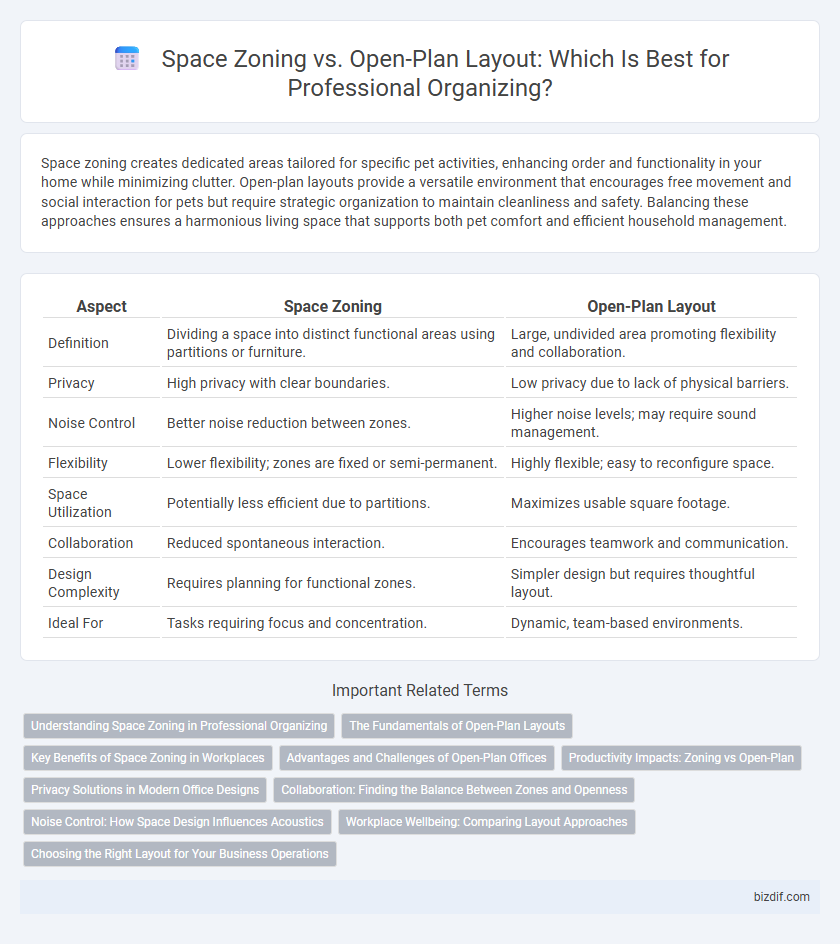Space zoning creates dedicated areas tailored for specific pet activities, enhancing order and functionality in your home while minimizing clutter. Open-plan layouts provide a versatile environment that encourages free movement and social interaction for pets but require strategic organization to maintain cleanliness and safety. Balancing these approaches ensures a harmonious living space that supports both pet comfort and efficient household management.
Table of Comparison
| Aspect | Space Zoning | Open-Plan Layout |
|---|---|---|
| Definition | Dividing a space into distinct functional areas using partitions or furniture. | Large, undivided area promoting flexibility and collaboration. |
| Privacy | High privacy with clear boundaries. | Low privacy due to lack of physical barriers. |
| Noise Control | Better noise reduction between zones. | Higher noise levels; may require sound management. |
| Flexibility | Lower flexibility; zones are fixed or semi-permanent. | Highly flexible; easy to reconfigure space. |
| Space Utilization | Potentially less efficient due to partitions. | Maximizes usable square footage. |
| Collaboration | Reduced spontaneous interaction. | Encourages teamwork and communication. |
| Design Complexity | Requires planning for functional zones. | Simpler design but requires thoughtful layout. |
| Ideal For | Tasks requiring focus and concentration. | Dynamic, team-based environments. |
Understanding Space Zoning in Professional Organizing
Space zoning in professional organizing refers to dividing an area into distinct functional sections, enhancing efficiency by clearly defining purposes for each zone. This method reduces clutter and improves workflow by tailoring storage and organization solutions to specific activities within the space. Unlike open-plan layouts, space zoning supports focused task management and promotes a sense of order, essential for productivity and stress reduction.
The Fundamentals of Open-Plan Layouts
Open-plan layouts emphasize maximizing natural light and fostering collaboration by minimizing physical barriers within a space. Key fundamentals include creating distinct functional zones without full partitions, utilizing furniture arrangements and color schemes to define areas, and maintaining clear sightlines to support communication. This design promotes flexibility and efficient use of space, enhancing productivity in professional environments.
Key Benefits of Space Zoning in Workplaces
Space zoning in workplaces enhances productivity by clearly defining functional areas, reducing distractions and creating a structured environment. It supports better organization by allocating specific zones for tasks such as collaboration, focused work, and meetings, leading to improved workflow and employee satisfaction. Space zoning also optimizes the use of available square footage, making offices more efficient and adaptable to changing team needs.
Advantages and Challenges of Open-Plan Offices
Open-plan offices enhance collaboration and communication by eliminating physical barriers, fostering a dynamic work environment that can boost team productivity and creativity. However, these layouts pose challenges such as increased noise levels and reduced privacy, which may lead to distractions and decreased individual focus. Effective use of sound-absorbing materials and designated quiet zones can mitigate these issues, balancing openness with the need for concentration.
Productivity Impacts: Zoning vs Open-Plan
Space zoning creates defined work areas that reduce distractions and enhance focus, leading to higher productivity compared to open-plan layouts. Open-plan layouts foster collaboration but often increase noise levels and interruptions, resulting in decreased individual task efficiency. Optimizing workspace productivity relies on balancing private zones with shared spaces to accommodate varied work styles and reduce cognitive overload.
Privacy Solutions in Modern Office Designs
Space zoning in modern office designs enhances privacy by creating designated areas for focused work, reducing distractions and improving productivity. Open-plan layouts prioritize collaboration but often require innovative privacy solutions such as acoustic panels, privacy screens, and strategic furniture placement to minimize noise and visual interruptions. Implementing a blend of space zoning within open-plan environments balances openness with personal privacy, optimizing both communication and concentration.
Collaboration: Finding the Balance Between Zones and Openness
Space zoning enhances collaboration by creating designated areas tailored to specific tasks, fostering focused teamwork and reducing distractions. Open-plan layouts encourage spontaneous interactions and idea sharing, boosting creativity and collective problem-solving. Balancing zones with open spaces optimizes workflow, enabling teams to shift seamlessly between individual focus and group collaboration for maximum productivity.
Noise Control: How Space Design Influences Acoustics
Space zoning creates distinct areas that effectively reduce noise transmission by containing sounds within designated zones, enhancing acoustic privacy. Open-plan layouts tend to amplify ambient noise due to lack of physical barriers, often requiring additional sound-absorbing materials or acoustic panels. Strategic space design directly influences sound control, improving comfort and productivity in professional environments.
Workplace Wellbeing: Comparing Layout Approaches
Space zoning enhances workplace wellbeing by creating dedicated areas for focused work, collaboration, and relaxation, reducing distractions and promoting mental clarity. Open-plan layouts encourage communication and flexibility but can increase noise levels and reduce privacy, potentially leading to employee stress. Implementing strategic space zoning within open-plan environments can balance interaction with individual comfort, optimizing overall employee wellbeing.
Choosing the Right Layout for Your Business Operations
Space zoning enhances business efficiency by clearly defining functional areas, improving workflow and minimizing distractions. Open-plan layouts promote collaboration and communication but may lead to noise distractions and reduced privacy. Selecting the right layout depends on business operations, balancing the need for interaction with focused, task-specific zones to optimize productivity.
Space zoning vs Open-plan layout Infographic

 bizdif.com
bizdif.com